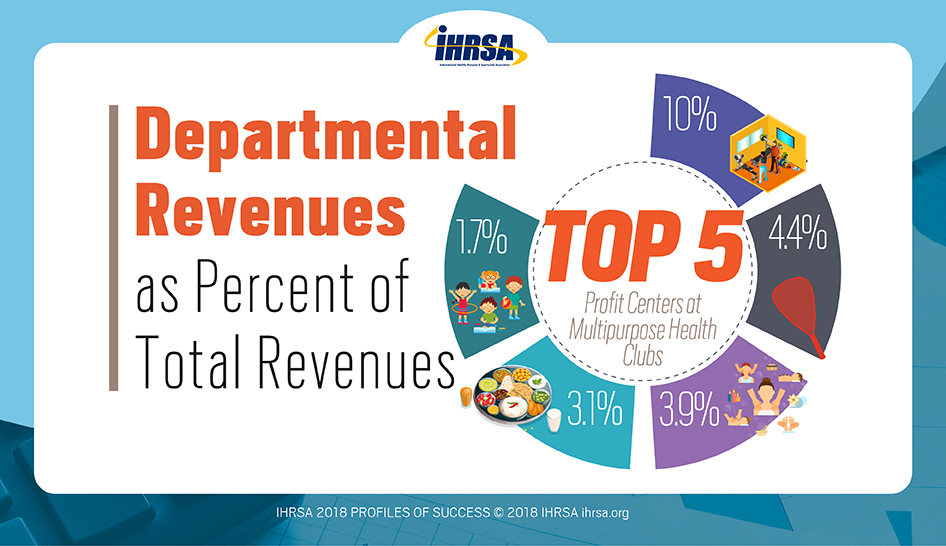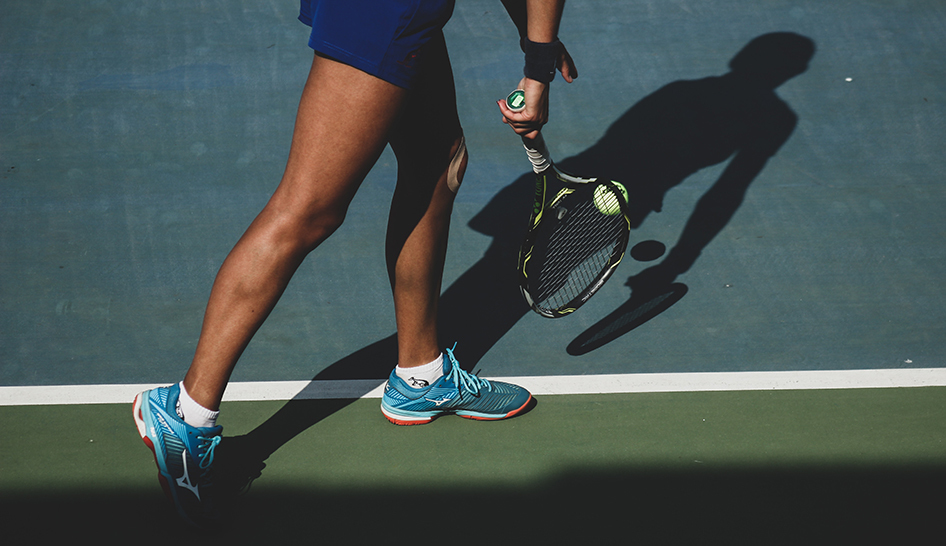IHRSA’s annual Profiles of Success analyzes performance of leading health and fitness clubs, including key performance indicators, profit center analysis, and financial statement data. Based on data gathered in the annual Industry Data Survey (IDS), the report aggregates and analyzes data from 115 club companies, representing 12,289 locations. If your club is among industry leaders, be sure to participate in this annual survey!
As Profiles of Success shows, while membership dues/fees revenue is the lifeblood of health clubs, top-tier clubs also generate a significant portion of revenue from non-dues services, including profit centers. IDS respondent clubs reported a median of 32.1% of total revenue coming from non-dues offerings. Understandably, non-dues revenues varies across club segments.
Top 5 Profit Centers at Multipurpose Health Clubs
While membership dues/fees revenue is the lifeblood of health clubs, top-tier clubs also generate a significant portion of revenue from non-dues services—including profit centers.

Leading multipurpose clubs generate a median of 33.6% of total revenue from non-dues profit centers, while fitness-only clubs derive a median of 21.8% of total revenue from ancillary sources. As you may expect, multipurpose clubs also generate more revenue per individual member at $764.60 versus $599.20 per member at fitness-only clubs. Multipurpose clubs typically have higher membership fees and a wider range of profit centers than fitness-only facilities.
Profiles of Success delves into some of the more profitable non-dues departments at health clubs. Here are the top five at successful multipurpose facilities.
5. Children & Youth Programming
Children and youth programming account for 1.7% of total revenue at leading multipurpose clubs. Through offers such as youth-friendly personal training, sports-specific instruction, and summer programs, just to name a few, the children and youth department ranks fifth among top profit centers at leading multipurpose clubs.
The IHRSA Health Club Consumer Report also highlights the profit potential of children and youth offerings. In 2017, roughly 9.5 million health club members in the U.S. were under the age of 18, accounting for 15.5% of total health club members. In 2012, 10% of total health club members were under the age of 18. As one of the fastest growing segments, the under 18 age group offers profit center opportunities for health clubs.
“Leading multipurpose clubs generate a median of 33.6% of total revenue from non-dues profit centers, while fitness-only clubs derive a median of 21.8% of total revenue from ancillary sources.”
4. Food & Beverage
Multipurpose clubs that participated in the IDS reported a median of 3.1% of total revenue derived from food and beverage, which ranks fourth among profit centers.
Multipurpose clubs tend to have a larger footprint and can accommodate food and beverage offerings with a restaurant or cafe and/or a beverage bar that serves smoothies, juices, and recovery drinks. These clubs are equipped with the space to supplement member fitness goals beyond their workouts.
3. Spa
Ranking third among profit centers, spas accounts for 3.9% of total revenue at top-tier multipurpose clubs. Again, as larger facilities, multipurpose clubs have the space to accommodate spa services, including massage and bodywork as well as hand and facial treatments.
Offering spa services is another way to complement member goals outside of training. Considering that leading fitness-only clubs also derived more than 3% of total revenue from spa services, it’s clear that high performing clubs are responding to member needs for recovery and rejuvenation. Along with food and beverage, the prevalence of spa offerings at clubs highlights a growing focus on wellness from both clubs and consumers.

2. Racquet
Understandably, racquet is the second-leading profit center at top multipurpose clubs. IDS multipurpose club operators reported a median of 4.4% of total revenue coming from racquet facilities such as tennis and racquetball.
Based on data from The IHRSA Health Club Consumer Report, 21% of multipurpose club members participate in tennis; approximately 9.5% of the same members participate in racquetball. Multipurpose clubs are uniquely positioned to offer racquet facilities and the best in the field (or court) generate a significant part of revenue from this profit center.
1. Personal Training
Consistent with historical data, personal training is the number one profit center at multipurpose clubs. Nearly 10% of total revenue is derived from personal training at multipurpose centers. According to the IHRSA Fitness Training Report, roughly 31% of members who use a personal trainer belong to a multipurpose facility. Personal training remains a critical revenue stream for multipurpose clubs as well as an important retention tool. Members who engage in personal training typically stay longer than members who do not use a personal trainer.
So there you have it! If you are a multipurpose club operator, do your top 5 profit centers vary from the above list? If so, please be sure to participate in IHRSA’s annual Industry Data Survey, available on the IHRSA Research Portal by March 1 each year. Your input will be valuable for in efforts to compile meaningful, representative data clubs (including your own) can use to benchmark their performance against.

Melissa Rodriguez is a Market Research Advisor for IHRSA. When she's not analyzing data and statistics, Melissa enjoys spending time with family, watching superhero series, poring over NBA and NFL box scores, and reading a good book.